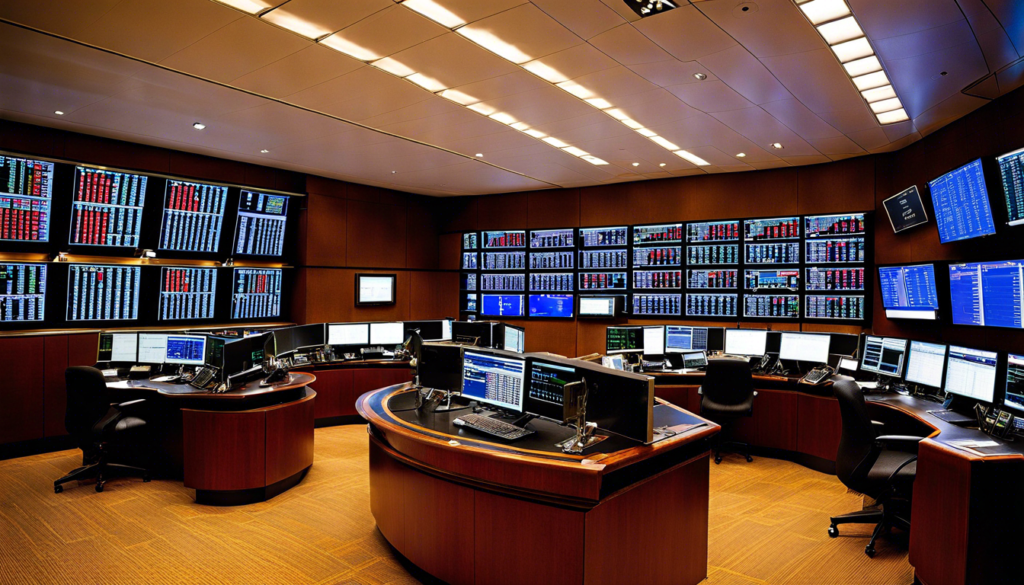Stock trading might seem complicated at first glance, but it’s essentially the buying and selling of ownership in companies. Stock exchanges are where this action happens, allowing investors to trade shares in a transparent and organized manner. Let’s explore how stocks are traded, what processes are involved, and what you need to know to get started.
Understanding Stock Exchanges
What is a Stock Exchange?
A stock exchange is a platform where stocks and other securities are traded between buyers and sellers. The exchange ensures that trading happens in a controlled, transparent, and efficient manner. It plays a critical role in the economy by facilitating the flow of capital and providing a venue for companies to raise funds.
Table 1: Major Global Stock Exchanges
| Stock Exchange | Country | Notable Features |
|---|---|---|
| New York Stock Exchange (NYSE) | USA | Largest by market capitalization, home to many blue-chip stocks. |
| NASDAQ | USA | Known for technology stocks, operates electronically. |
| London Stock Exchange (LSE) | UK | One of the oldest, serving global markets. |
| Tokyo Stock Exchange (TSE) | Japan | Largest in Asia, key for Asian markets. |
Stock Exchange vs. Over-the-Counter (OTC) Markets
- Stock Exchange: Centralized, regulated, and formal trading environment.
- OTC Markets: Decentralized, less formal, often involving smaller or less liquid securities.
The Process of Buying Stocks
1. Setting Up a Brokerage Account
Before you start buying stocks, you need to set up a brokerage account. This account acts as your gateway to the stock market, allowing you to place orders to buy or sell stocks.
2. Choosing Stocks:
- Fundamental Analysis: Assess the financial health, management, and future prospects of a company.
- Technical Analysis: Study past price movements and trading volumes to predict future trends.
List: Steps to Analyze Stocks
- Review the company’s financial statements.
- Compare key ratios (P/E, ROI).
- Study market trends.
- Consider industry performance.
3. Placing a Buy Order
Once you’ve selected a stock, you need to place a buy order.
Table 2: Types of Buy Orders
| Order Type | Description |
|---|---|
| Market Order | Executes immediately at the current market price. |
| Limit Order | Executes only at your specified price or better. |
| Day Order | Valid only for the trading day; expires if not executed. |
| Good ‘Til Canceled (GTC) Order | Stays active until it’s either executed or you cancel it. |
4. Executing the Trade
Once the order is placed, your broker sends it to the stock exchange. The exchange matches your buy order with a seller’s sell order, and the trade is executed.
5. Settlement Process
The settlement process typically follows a T+2 cycle, meaning the transaction is completed two business days after the trade. During this time, ownership of the stock and payment are finalized.
Suggested Image: Flowchart illustrating the steps from placing an order to settlement.
The Process of Selling Stocks
1. When to Sell Stocks
Knowing when to sell is just as important as knowing when to buy. Key indicators include meeting your financial goals, changes in company fundamentals, or rebalancing your portfolio.
List: Reasons to Sell a Stock
- Company underperforms.
- Achieved your investment target.
- Need to diversify your portfolio.
2. Placing a Sell Order
Similar to buying, selling involves placing an order through your broker.
Table 3: Types of Sell Orders
| Order Type | Description |
|---|---|
| Market Order | Sells immediately at the current market price. |
| Limit Order | Sells only at your specified price or better. |
3. Settlement Process for Selling
The settlement process for selling stocks is similar to buying. It usually follows the same T+2 cycle, ensuring the smooth transfer of ownership and payment.
Key Takeaway: The T+2 cycle is standard in the industry, meaning transactions are settled two business days after the trade.
Role of Brokers in Stock Trading
1. Full-Service Brokers vs. Discount Brokers
- Full-Service Brokers: Offer personalized advice and a wide range of services, but at a higher cost.
- Discount Brokers: Provide essential services at lower fees, often through online platforms.
2. Online Trading Platforms
Online trading platforms have democratized stock trading, offering tools for analysis, research, and order placement from the comfort of your home.
3. Fees and Commissions
Brokers charge fees and commissions for their services. It’s essential to understand these costs as they can impact your returns.
List: Common Broker Fees
- Trading commissions.
- Account maintenance fees.
- Inactivity fees.
Market Participants in Stock Trading
1. Retail Investors
Individual investors who trade for personal accounts.
2. Institutional Investors
Large entities like mutual funds, pension funds, and hedge funds that trade in significant volumes.
3. Market Makers
Entities that ensure liquidity by being ready to buy or sell stocks at any time, keeping the market active.
4. High-Frequency Traders
Traders using advanced algorithms to execute trades in milliseconds, capitalizing on small price discrepancies.
The Role of Stock Prices
1. How Stock Prices Are Determined
Stock prices are determined by the forces of supply and demand. If more people want to buy a stock, its price goes up. If more want to sell, the price goes down.
Table 4: Factors Influencing Stock Prices
| Factor | Impact on Stock Prices |
|---|---|
| Earnings Reports | Strong earnings usually drive prices up. Weak earnings tend to lower prices. |
| Economic Indicators | Interest rates, inflation, and employment figures can influence prices. |
| Market Sentiment | News, investor emotions, and events can cause short-term price fluctuations. |
2. Factors Influencing Stock Prices
- Earnings Reports: Directly impact investor perception and stock prices.
- Economic Indicators: Broader economic conditions can sway stock prices.
- Market Sentiment: Investor emotions and reactions to news can cause rapid changes in stock prices.
Suggested Image: A graph showing stock price movement influenced by key factors like earnings reports and economic indicators.
Types of Stock Orders
1. Market Orders
Market orders are the simplest and most common type, executed immediately at the best available price.
2. Limit Orders
A limit order allows you to set the maximum price you’re willing to pay or the minimum price you’re willing to accept.
3. Stop-Loss Orders
These orders automatically sell your stock if it falls to a specific price, helping to limit your losses.
4. Trailing Stop Orders
A trailing stop order adjusts with the stock price, allowing you to lock in profits as the stock price increases while protecting against downside risk.
Trading Strategies
1. Day Trading
Day trading involves buying and selling stocks within the same day to capitalize on short-term price movements.
2. Swing Trading
Swing traders hold stocks for several days or weeks to profit from expected upward or downward price swings.
3. Long-Term Investing
Long-term investors buy stocks with the intention of holding them for years, benefiting from the growth of the company over time.
4. Dividend Investing
Dividend investors focus on stocks that pay regular dividends, generating income in addition to potential capital gains.
Key Takeaway: Different trading strategies suit different types of investors. Choose a strategy based on your financial goals, risk tolerance, and market knowledge.
Risks Involved in Stock Trading
List: Common Risks in Stock Trading
- Market Risk: The risk of losing money due to changes in the market.
- Liquidity Risk: The risk that you may not be able to sell your stock quickly at a fair price.
- Volatility Risk: The risk of significant price fluctuations in a short period.
- Credit Risk: The risk that the company issuing the stock may go bankrupt.
The Role of Technology in Stock Trading
1. Electronic Trading Platforms
Electronic platforms have revolutionized trading by making it faster, more efficient, and accessible to everyone.
2. Algorithmic Trading
Algorithmic trading uses complex algorithms to execute trades at high speeds, often without human intervention.
3. Impact of Artificial Intelligence on Stock Trading
AI is increasingly used for predictive analytics, risk management, and executing trades, making trading more sophisticated and data-driven.
Suggested Image: Diagram showing how technology, including AI and algorithms, influences modern stock trading.
Regulations in Stock Trading
1. Securities and Exchange Commission (SEC) Role
The SEC regulates the stock market in the United States, ensuring transparency, fairness, and investor protection.
2. Insider Trading Laws
Insider trading is illegal and involves trading based on non-public, material information about a company.
3. Role of Regulatory Bodies Globally
Different countries have their regulatory bodies (e.g., Financial Conduct Authority in the UK) to oversee market activities and protect investors.
The Settlement Process
1. T+2 Settlement Cycle
The T+2 settlement cycle means the transaction is settled two business days after the trade date.
2. Clearinghouses and Their Role
Clearinghouses act as intermediaries between buyers and sellers, ensuring that trades are settled correctly.
3. Depositories and Custodians
Depositories hold securities in electronic form, while custodians manage and safeguard the assets.
Common Mistakes to Avoid in Stock Trading
List: Common Trading Mistakes
- Emotional Trading: Making decisions based on emotions rather than analysis.
- Ignoring Market Research: Not conducting adequate research before making trades.
- Overtrading: Trading too frequently, which can lead to higher costs and potential losses.
Key Takeaway: Avoid emotional trading, do your research, and don’t overtrade. These are crucial for success in stock trading.


